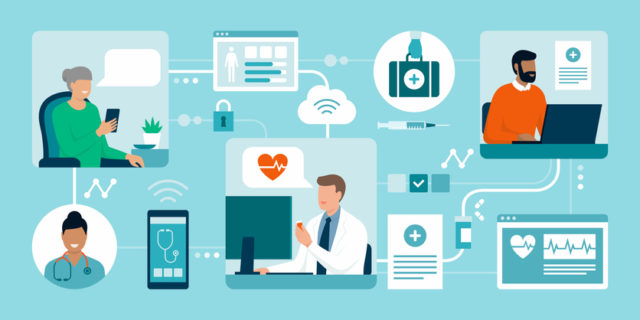
Technology is advancing at lightning speed across every industry sector, and healthcare is no exception. Operating rooms (ORs) have become dominated by tech innovations that assist surgical procedures such as 3D imagery and robotics. Yet, despite these advances, clinical communication technologies that facilitate more effective collaboration between caregivers have yet to fully evolve.
Communication characteristics of healthcare settings
For years, the Joint Commission emphasized the need for improving communication and information sharing effectiveness among medical teams to enhance patient care. Hospitals and surgical suites are dynamic environments where multi-disciplinary clinicians rely on myriad information and communication technologies. This multi-layered approach is still common and is compounded by outdated communications systems used in many healthcare facilities. Some are a complicated mix of landline phones, pagers, and whiteboards. Others rely on two-way radio systems that are regularly subject to reception issues and low audio quality. Clinicians often carry too many single-purpose devices, making it more difficult to share information in a timely manner. As it is, communications among complex care teams is already a challenge while wearing personal protective equipment (PPE), face shields, and masks.
Overhead paging systems have been a mainstay in hospitals and medical centers for eons. However, constant announcements contribute to a noisy and stressful environment, which can correlate with poorer outcomes and lower Hospital Consumer Assessment of Healthcare Providers and Systems (HCAHPS) scores.
Healthcare design also plays a role in communication quality and workflows. For example, data shows nurses spend one fifth of their shift coordinating care with team members in other departments and routinely walk up to five miles in 10 hours. Some studies show nurses waste 10 to 25 percent of their time searching for another staff member.
Delays caused by poor communications contribute to slower response times, workflow inefficiencies, and impact critical decision-making, leading to poorer patient outcomes. Where ORs are concerned, delays in activities necessary for pre-op preparation, procedures, and post-op care can cost millions per annum. An average OR minute costs $130, which translates to $1.56 million for 12,000 surgeries performed in a year.
In an environment where patient safety reigns above all else, communication gaps and misinterpreted information are often responsible for serious medical errors and operational failures, which may cause preventable patient health complications.
To truly enhance the quality of care, healthcare organizations need more collaborative, less disruptive communication tools that enable greater workflow efficiencies, faster response times, fewer errors, and higher levels of safety.
Transformative mobile clinical technologies
The adoption of mobile platforms for mission-critical clinical communications has begun to proliferate in healthcare. Mobile systems are primarily comprised of software applications and hardware devices that operate on a wireless network.
Wireless push-to-talk (PTT) over cellular (PoC) is one example of a mobile communications technology that has transformative potential for medical teams. In essence, PoC turns mobile devices like smartphones and tablets into walkie-talkies with Wi-Fi or cellular network connectivity. Cellular infrastructure provides a highly reliable network with unlimited coverage that requires no maintenance or operational expenses.
PoC also supports the use of encrypted voice messaging apps, which allow clinicians to reach team members both inside the hospital and remotely, while still maintaining confidentiality. It enables instant and discreet conversations with an individual or with groups, by channels or even by roles. Voice messaging apps offer valuable functions, such as record and playback, location tracking, and emergency alerts. They may also include secure text messaging or support video calls, enabling more effective communications between care teams, with patients, and with families.
Because clinicians perform multiple tasks while continually on the move, having to stop to use an app on a handheld device isn’t always feasible and can be intrusive to patients. The emergence of specialized wireless hardware accessories has made it faster and less disruptive to access PoC applications. For example, with the press of a finger, wireless PTT buttons control PoC apps on mobile devices, providing virtually hands-free communications. In addition, because they use Bluetooth Low Energy (BTLE) technologies, the buttons run for at least two years on a single coin cell battery.
In recent years, surgeons and anesthesiologists have begun using wireless PTT buttons with PoC apps in the OR during clean procedures while prepping patients. They’ve even found a way to use the system during sterile procedures, simply by having an OR assistant press the PTT button for the doctor to speak via the app.
Another hands-free technology to emerge is wearable badges that use voice-over-internet protocol (VoIP) on a wireless network, which enable caregivers to handle calls or receive messages and notifications without using a handset. In emergencies, teams can use voice commands to call by name, role, or group. A caveat is this technology is often part of a complete solution that includes the mobile application and devices.
Though most PoC applications and accessories are compatible with Android and iOS devices, the iOS platform is reputed to have more robust security and a user-friendly interface. Consequently, healthcare institutions are more inclined to deploy iPhones as multi-purpose devices with clinical iOS apps as a simple, scalable communication solution. Third-party apps on iPhones can expand capabilities to enable VoIP calls, access reference materials, scan barcodes, document patient information, and more. One consideration is whether these devices are rugged enough to withstand the rigors of surgical and hospital environments. Hence, hardware developers are introducing more durable options for clinical collaboration.
Ultimately, software applications are driving the adoption of wireless technologies in healthcare as a means for consolidating caregiver communications. Many mobile clinical platforms integrate with existing systems, such as nurse calling, patient records, or monitoring, and support remote collaboration and telemedicine. The end result is a comprehensive clinical communications solution designed for medical professionals.
Responsible use yields greater outcomes
As more healthcare facilities adopt smartphones, more challenges have emerged. Hospitals have conflicting opinions over whether it is best to use personnel-owned (BYOD) or hospital-owned devices. Concerns have also been raised over the potential for devices to become a distraction or cause infections for vulnerable patients.
The Association of Surgical Technologists (AST) provides best practices for using mobile technologies in the OR. Guidelines for healthcare organizations include establishing policies and procedures for the appropriate use of mobile devices, and ensuring they are cleaned and disinfected before being used in critical care areas.
The AST outlines rationale that supports the use of mobile devices in medical practices, and highlights several efficiency advantages:
- Decrease in medical errors
- Faster access to patient information
- Improved communication with patients
- Higher work productivity and efficiency
- Lower failure-to-respond rate
Time is one of the most precious assets in the healthcare, not only for patient care but also in economic terms. Improving efficiencies by doing more in less time can save hospitals millions of dollars and, most of all, expedited real-time communications with fewer interruptions can save millions of lives.
Nonetheless, implementing new technologies inevitably comes with challenges. Practitioners must work together with informaticists and IT personnel to ensure goals are aligned and teams are trained to make communications as seamless as possible. In time, the medical community will embrace enhanced mobile clinical communications as a strategic solution to enhanced patient care.
Photo: elenabs, Getty Images








